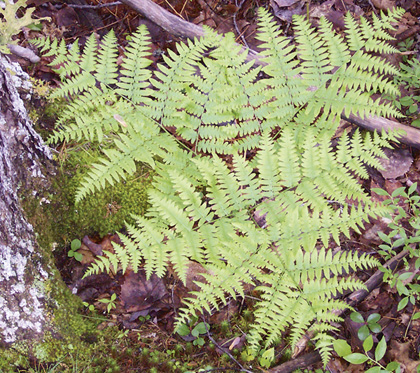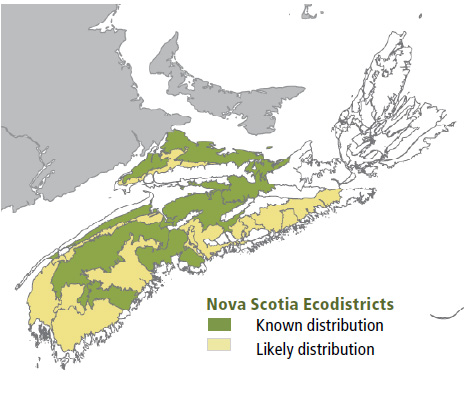
Forest Vegetation types - SP2
SP2 — Red pine / Blueberry / Bracken
Pinus resinosa / Vaccinium spp. / Pteridium aquilinum
SP2a — Black spruce variant
Picea mariana
 |
Aldershot, Kings County |
Concept: This early to mid-successional Vegetation Type (VT) has significant red pine in the overstory and black spruce in one or more layers. Occurrences dominated by black spruce with lesser red pine are defined by the SP2a variant. These variant stands either occur at a later successional stage or are characterized by less red pine at the time of stand establishment. SP2 is similar to SP3 (Red Pine - White pine / Bracken - Mayflower), but is distinguished by the nearly homogeneous overstory of red pine. SP2 usually follows stand-replacing disturbance events such as fire or harvesting.
Vegetation: Red pine is typically the dominant overstory tree, although black spruce cover can be significant. The shrub layer consists mainly of ericaceous species such as lambkill, velvet-leaf blueberry and lowbush blueberry, along with wild raisin. Black spruce and red maple regeneration can also be extensive. Herb layer diversity is low, typically dominated by bracken and teaberry. Abundant Schreber's moss characterizes the bryophyte layer, but a needle carpet can also be found in dense stands.
Environmental Setting: SP2 occurs on dry to moist, nutrient very poor to poor soils. Drier sites are generally associated with glaciofluvial deposits or shallow, gravelly and/or coarse textured glacial tills found in the Western ecoregion. Moist sites are mainly associated with finer textured soils (e.g. sandy clay loam) found in the Central Lowlands and Northumberland Lowlands ecodistricts. SP2 may be interspersed with OW4 (Red pine - White Pine/ Broom crowberry / Grey reindeer lichen) in some areas. This VT is very rare on Prince Edward Island and somewhat uncommon in New Brunswick.
Successional Dynamics: Dry, nutrient poor soils and stand-replacing disturbances strongly shape both the canopy structure and successional patterns of SP2. Historically SP2 stands originated from a few residual trees that survived high intensity fires. (Fire scars can often be found on the older trees at a site). Occasional, low intensity fires would have maintained red pine presence by eliminating or reducing undergrowth competition. SP2 stands are predominantly even-aged until red pine succumbs to senescence and is gradually replaced by black spruce, balsam fir, red oak and/or white pine. Dominance of these latter tree species increases over time, especially as the potential impacts of fire are reduced through management. Later successional stages may include SP4 (White pine / Blueberry / Bracken) or advance directly to SP5 (Black spruce / Lambkill / Bracken), the edaphic climax for this successional pathway.
Ecological Features: This closed canopy forest occurs as small to large patches. Red pine is shade-intolerant and usually requires fire to regenerate to near-pure forests. As such, fire suppression practices may reduce the abundance of this ecosystem. Fire scars on residual pine are often found scattered through SP2 stands and can lead to the formation of hollow trunks. The acidity (low nutrient content) of the forest floor (due to the abundance of pine needles and ericaceous vegetation) reduces soil fauna, plant diversity, and vertebrate diversity and abundance. Seeds of red pine may provide food for pine siskins, nuthatches and chickadees. Saffron milkcap is a well-known edible mushroom that forms
a mycorrhizal relationship with red pine.
 |
| Bracken |
Distinguishing Features: Red pine is diagnostic for this vegetation type found with scattered black spruce. Ericaceous species such as lambkill, blueberry and rhodora are common. In the variant, SP2a, black spruce is co-dominant with red pine. A needle carpet condition exists in stands with closed canopies.
| Slope Position: | Level3 Upper3 Middle2 Other2 |
Surface Stoniness: |
(Non - Slightly)8 (Moderately)1 (Very - Excessively)1 |
Bedrock Outcrop: |
(Non-rocky)10 |
Elevation Range: |
9 - 199m |
Slope Gradient: |
Gentle5 Level3 Moderate1 nd1 |
Aspect: |
North2 East2 South2 West2 None2 |
Exposure: |
Moderate10 |
Microtopography: |
Slightly6 Moderately2 Level1 Strongly1 |
Drainage: |
Well4 Imperfect2 Moderately well2 Rapid2 |
Soil Type: |
ST14 ST24 Other2 |
Parent Material: |
Glacial till6 Glaciofluvial3 Till/Bedrock1 |
Rooting Depth (cm): |
(<30)4 (30-45)1 (>45)4 nd1 |
Duff Thickness (cm): |
(0-5)1 (6-10)4 (11-20)4 nd1 |

